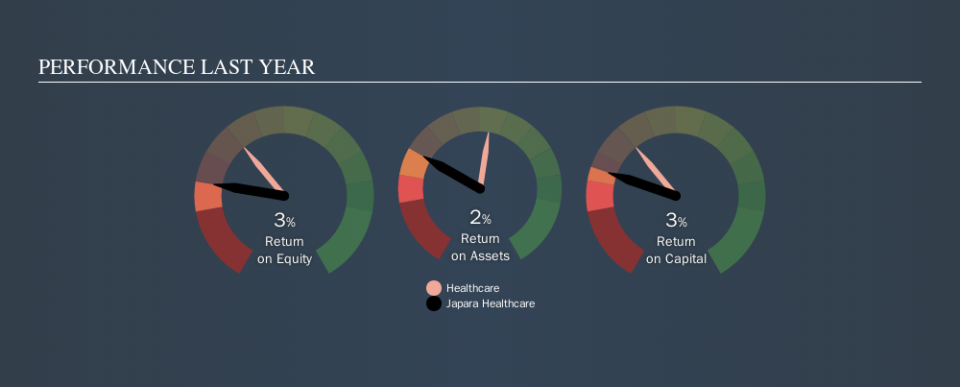How Do Japara Healthcare Limited’s (ASX:JHC) Returns On Capital Compare To Peers?

Today we'll evaluate Japara Healthcare Limited (ASX:JHC) to determine whether it could have potential as an investment idea. In particular, we'll consider its Return On Capital Employed (ROCE), as that can give us insight into how profitably the company is able to employ capital in its business.
First, we'll go over how we calculate ROCE. Then we'll compare its ROCE to similar companies. Last but not least, we'll look at what impact its current liabilities have on its ROCE.
What is Return On Capital Employed (ROCE)?
ROCE measures the 'return' (pre-tax profit) a company generates from capital employed in its business. Generally speaking a higher ROCE is better. Ultimately, it is a useful but imperfect metric. Author Edwin Whiting says to be careful when comparing the ROCE of different businesses, since 'No two businesses are exactly alike.
So, How Do We Calculate ROCE?
The formula for calculating the return on capital employed is:
Return on Capital Employed = Earnings Before Interest and Tax (EBIT) ÷ (Total Assets - Current Liabilities)
Or for Japara Healthcare:
0.035 = AU$25m ÷ (AU$1.4b - AU$668m) (Based on the trailing twelve months to June 2019.)
Therefore, Japara Healthcare has an ROCE of 3.5%.
View our latest analysis for Japara Healthcare
Is Japara Healthcare's ROCE Good?
ROCE is commonly used for comparing the performance of similar businesses. We can see Japara Healthcare's ROCE is meaningfully below the Healthcare industry average of 9.5%. This could be seen as a negative, as it suggests some competitors may be employing their capital more efficiently. Independently of how Japara Healthcare compares to its industry, its ROCE in absolute terms is low; especially compared to the ~2.3% available in government bonds. There are potentially more appealing investments elsewhere.
Japara Healthcare's current ROCE of 3.5% is lower than its ROCE in the past, which was 7.3%, 3 years ago. This makes us wonder if the business is facing new challenges. The image below shows how Japara Healthcare's ROCE compares to its industry, and you can click it to see more detail on its past growth.
Remember that this metric is backwards looking - it shows what has happened in the past, and does not accurately predict the future. ROCE can be misleading for companies in cyclical industries, with returns looking impressive during the boom times, but very weak during the busts. ROCE is, after all, simply a snap shot of a single year. Future performance is what matters, and you can see analyst predictions in our free report on analyst forecasts for the company.
What Are Current Liabilities, And How Do They Affect Japara Healthcare's ROCE?
Liabilities, such as supplier bills and bank overdrafts, are referred to as current liabilities if they need to be paid within 12 months. The ROCE equation subtracts current liabilities from capital employed, so a company with a lot of current liabilities appears to have less capital employed, and a higher ROCE than otherwise. To counteract this, we check if a company has high current liabilities, relative to its total assets.
Japara Healthcare has total liabilities of AU$668m and total assets of AU$1.4b. Therefore its current liabilities are equivalent to approximately 48% of its total assets. With a medium level of current liabilities boosting the ROCE a little, Japara Healthcare's low ROCE is unappealing.
What We Can Learn From Japara Healthcare's ROCE
This company may not be the most attractive investment prospect. You might be able to find a better investment than Japara Healthcare. If you want a selection of possible winners, check out this free list of interesting companies that trade on a P/E below 20 (but have proven they can grow earnings).
There are plenty of other companies that have insiders buying up shares. You probably do not want to miss this free list of growing companies that insiders are buying.
We aim to bring you long-term focused research analysis driven by fundamental data. Note that our analysis may not factor in the latest price-sensitive company announcements or qualitative material.
If you spot an error that warrants correction, please contact the editor at editorial-team@simplywallst.com. This article by Simply Wall St is general in nature. It does not constitute a recommendation to buy or sell any stock, and does not take account of your objectives, or your financial situation. Simply Wall St has no position in the stocks mentioned. Thank you for reading.

